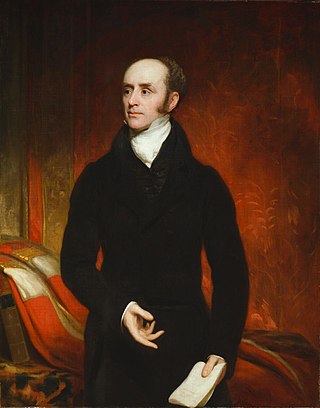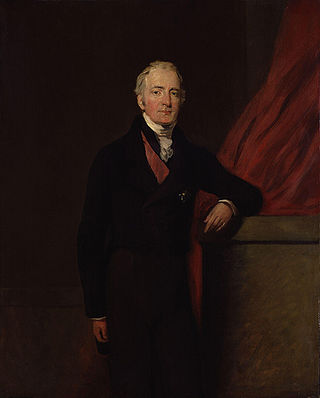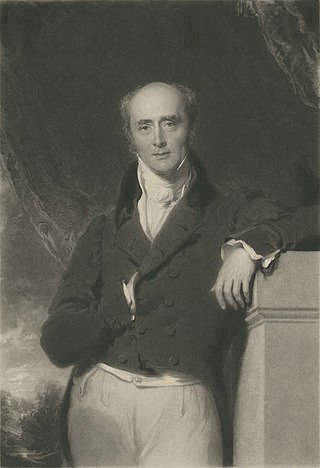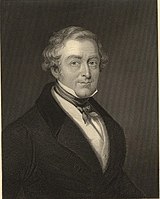
George Hamilton-Gordon, 4th Earl of Aberdeen,, styled Lord Haddo from 1791 to 1801, was a British statesman, diplomat and landowner, successively a Tory, Conservative and Peelite politician and specialist in foreign affairs. He served as Prime Minister from 1852 until 1855 in a coalition between the Whigs and Peelites, with Radical and Irish support. The Aberdeen ministry was filled with powerful and talented politicians, whom Aberdeen was largely unable to control and direct. Despite his trying to avoid this happening, it took Britain into the Crimean War, and fell when its conduct became unpopular, after which Aberdeen retired from politics.

Sir Robert Peel, 2nd Baronet,, was a British Conservative statesman who served twice as Prime Minister of the United Kingdom, simultaneously serving as Chancellor of the Exchequer (1834–1835), and twice as Home Secretary. He is regarded as the father of modern British policing, owing to his founding of the Metropolitan Police Service. Peel was one of the founders of the modern Conservative Party.

John Russell, 1st Earl Russell,, known by his courtesy title Lord John Russell before 1861, was a British Whig and Liberal statesman who served as Prime Minister of the United Kingdom from 1846 to 1852 and again from 1865 to 1866.

Edward George Geoffrey Smith-Stanley, 14th Earl of Derby,, known as Lord Stanley from 1834 to 1851, was a British statesman and Conservative politician who served three times as Prime Minister of the United Kingdom. To date, he is the longest-serving leader of the Conservative Party. He is one of only four British prime ministers to have three or more separate periods in office. However, his ministries each lasted less than two years and totalled three years and 280 days. Derby introduced the state education system in Ireland, and reformed Parliament.

Charles Grey, 2nd Earl Grey, known as Viscount Howick between 1806 and 1807, was a British Whig politician who served as Prime Minister of the United Kingdom from 1830 to 1834. He was a descendant of the House of Grey and the namesake of Earl Grey tea. Grey was a long-time leader of multiple reform movements. During his time as prime minister, his government brought about two notable reforms. The Reform Act 1832 enacted parliamentary reform, greatly increasing the electorate of the House of Commons.

William Henry Cavendish Cavendish-Bentinck, 3rd Duke of Portland, was a British Whig and then a Tory politician during the late Georgian era. He served as Chancellor of the University of Oxford (1792–1809) and as Prime Minister of Great Britain (1783) and then of the United Kingdom (1807–1809). The gap of 26 years between his two terms as Prime Minister is the longest of any British Prime Minister. He was also the fourth great-grandfather of King Charles III through his great-granddaughter Cecilia Bowes-Lyon, Countess of Strathmore and Kinghorne.

Frederick John Robinson, 1st Earl of Ripon,, styled The Honourable F. J. Robinson until 1827 and known between 1827 and 1833 as The Viscount Goderich, the name by which he is best known to history, was a British politician who served as Prime Minister of the United Kingdom from 1827 to 1828.

Henry Bathurst, 3rd Earl Bathurst, was a High Tory, High Church Pittite. He was an MP for thirty years before ennoblement. A personal friend of William Pitt the Younger, he became a broker of deals across cabinet factions during the Napoleonic era. After the Napoleonic Wars, Bathurst was on the conservative wing of the Tory party.
The Tamworth Manifesto was a political manifesto issued by Sir Robert Peel in 1834 in Tamworth, which is widely credited by historians as having laid down the principles upon which the modern British Conservative Party is based.

Charles Watkin Williams-Wynn PC was a British politician of the early- to mid-19th century. He held office in both Tory and Whig administrations and was Father of the House of Commons between 1847 and 1850.

The Whig government of the United Kingdom of Great Britain and Ireland that began in November 1830 and ended in November 1834 consisted of two ministries: the Grey ministry and then the first Melbourne ministry.

King William IV had dismissed the Whig government of Lord Melbourne on 14 November 1834 and asked the Duke of Wellington to form a government but he declined, instead recommending Sir Robert Peel. Peel was in Sardinia at the time, so the Duke of Wellington took control of the government in a caretaker capacity until Peel returned and was able to form his government on 10 December.

The second Peel ministry was formed by Sir Robert Peel in the United Kingdom of Great Britain and Ireland in 1841.

The 1830 United Kingdom general election was triggered by the death of King George IV and produced the first parliament of the reign of his successor, King William IV. Fought in the aftermath of the Swing Riots, it saw electoral reform become a major election issue. Polling took place in July and August and the Tories won a plurality over the Whigs, but division among Tory MPs allowed Earl Grey to form an effective government and take the question of electoral reform to the country the following year.

The Bedchamber crisis occurred on 7 May 1839 after Whig politician William Lamb, 2nd Viscount Melbourne declared his intention to resign as Prime Minister of the United Kingdom after a government bill passed by a very narrow margin of only five votes in the House of Commons. Following a few false moves toward an alternative Tory prime minister and a Conservative government, Lord Melbourne was reinstated until the 1841 election, when the Conservative party took over.

The Conservative government of the United Kingdom of Great Britain and Ireland that began in 1828 and ended in 1830 was led by the Duke of Wellington in the House of Lords and Robert Peel in the House of Commons.
The Ultra-Tories were an Anglican faction of British and Irish politics that appeared in the 1820s in opposition to Catholic emancipation. The faction was later called the "extreme right-wing" of British and Irish politics.

The Canningites, led by George Canning and then the Viscount Goderich as First Lord of the Treasury, governed the United Kingdom of Great Britain and Ireland from 1827 until 1828.

The Sacramental Test Act 1828 was an Act passed by the Parliament of the United Kingdom. It repealed the requirement that government officials take communion in the Church of England. Sir Robert Peel took the lead for the Tory government in the repeal and collaborated with Anglican Church leaders.



















